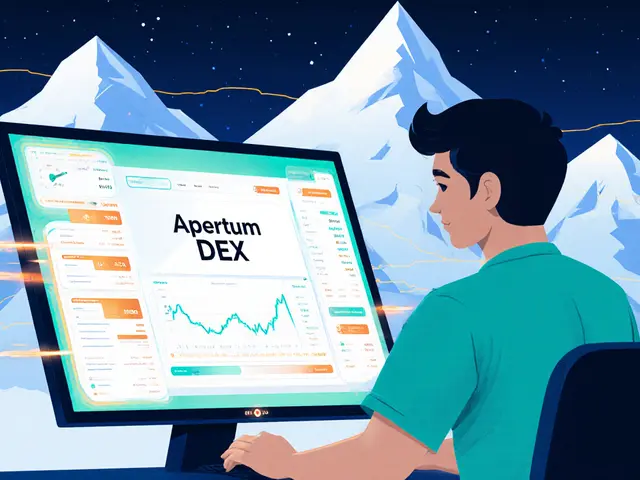CAD Coin (CADC) Value Calculator
Calculate Your CADC Holdings
Your Holdings Summary
You own 0 CADC tokens
Value in Canadian Dollars: $0.00 CAD
Value in US Dollars: $0.00 USD
Exchange Rate Used: 1.38 CAD/USD
Key Takeaways
- CAD Coin (CADC) is a fully reserve‑backed stablecoin that mirrors the Canadian dollar 1:1.
- It runs on Ethereum and the Base layer‑2, using Circle’s proven USDC smart‑contract code.
- PAYTRIE AB Inc. holds a FINTRAC licence, giving CADC a regulatory edge over many unregulated stablecoins.
- Buy CADC on PayTrie with Interac e‑transfer or on decentralized exchanges like Aerodrome.
- Current market cap sits around $750,000 USD, with a 24‑hour volume of roughly $800,000 USD.
When crypto‑savvy Canadians ask, "What is CAD Coin (CADC)?", they’re looking for a digital version of the Canadian dollar Canada’s official fiat currency, symbol CAD that can move instantly on a blockchain. In plain English, CADC is a stablecoin a cryptocurrency designed to keep a stable value by being pegged to a real‑world asset backed 100% by Canadian dollars held in reserve accounts.
What is CAD Coin?
CAD Coin (CADC) a Canadian‑dollar‑backed stablecoin launched by PAYTRIE AB Inc. aims to give crypto users a fiat‑free way to hold CAD, earn DeFi yields, or settle payments without converting to USD first. Each CADC token is redeemable on a 1:1 basis for physical Canadian dollars via the PayTrie platform, eliminating foreign‑exchange risk for Canadians who trade on global markets.
How Does the Peg Work?
When you buy one CADC, PAYTRIE moves an equivalent Canadian dollar into a locked reserve account. The smart contract marks that token as "fully backed" and records the ownership on the blockchain. If you later want to cash out, you submit a redemption request on PayTrie; the company releases the CAD from its reserve and burns the corresponding token. This1:1 redemption model mirrors the approach used by industry giants like USDC a USD‑backed stablecoin built on Circle’s codebase and USDT Tether’s USD stablecoin, the world’s most traded token, but applies it to the Canadian market.
Technical Backbone
CADC’s code is a fork of Circle’s battle‑tested USDC a highly audited ERC‑20 contract that defines minting, burning, and pausing logic. By re‑using this proven framework, PayTrie avoids many of the security pitfalls that plague brand‑new contracts.
The token lives on two networks:
- Ethereum the original smart‑contract platform, known for high security but higher gas fees
- Base a layer‑2 solution built by Coinbase, offering lower fees and faster finality
Running on both chains gives users flexibility: high‑value moves can stay on Ethereum for maximum liquidity, while everyday swaps and DeFi interactions often migrate to Base to save on transaction costs (typically under $1 compared to $10‑$50 on Ethereum).
Regulatory Landscape
PAYTRIE AB Inc. operates under a FINTRAC licence (Canada’s Financial Transactions and Reports Analysis Centre). FINTRAC the Canadian financial‑intelligence agency that enforces anti‑money‑laundering and counter‑terrorism financing rules oversight means PayTrie must keep detailed transaction records, perform KYC on users, and maintain AML controls. This regulatory badge sets CADC apart from many unregulated stablecoins that operate in a gray‑area jurisdiction.
Because CADC is fully reserve‑backed and regulated, Canadian banks have begun to view it as a low‑risk digital asset. The Bank of Canada’s ongoing CBDC research could eventually introduce an official digital Canadian dollar, but for now CADC remains the only private‑sector option that combines on‑chain accessibility with legal compliance.

How to Acquire CADC
There are two main paths:
- Direct fiat purchase: Canadians can log into the PayTrie portal, link an Interac e‑transfer, and receive CADC in their wallet instantly. The process usually takes 5‑15minutes and costs negligible platform fees.
- Decentralized exchange (DEX) route: International users or Canadians who already hold crypto can swap ETH, WETH, or USDC for CADC on DEXs like Aerodrome SlipStream (Ethereum) or Aerodrome Base (Layer‑2). You’ll need a wallet that supports ERC‑20 tokens (e.g., MetaMask, Trust Wallet) and a small amount of ETH or Base to cover gas.
Remember to add the CADC contract address to your wallet manually if it doesn’t appear automatically. The contract address is publicly listed on PayTrie’s documentation and can be verified on Etherscan or Base‑scan.
Use Cases for CADC
Because CADC holds its value in CAD, it shines in scenarios where users want crypto flexibility without currency conversion risk:
- DeFi lending: Platforms on Base accept CADC as collateral, letting you earn interest in other tokens while your principal stays pegged to the Canadian dollar.
- Cross‑border payments: A freelancer in Toronto can invoice a client in Vancouver with CADC, avoiding bank transfer delays and fees.
- Liquidity provision: Providing CADC/WETH or CADC/USDC liquidity on Aerodrome earns fees that can be harvested in CAD‑denominated returns.
- Hedging: Canadian traders who hold US‑based assets can quickly move into CADC to hedge against USD volatility.
Current Market Snapshot
As of October2025, CADC trades around $0.72USD per token, reflecting the CAD‑USD exchange rate (≈1.38CAD perUSD). The circulating supply is roughly 1.06million CADC, giving the token a market cap between $630k and $770kUSD depending on the data source. Daily trading volume hovers near $800kUSD, with the CADC/USDC pair accounting for the lion’s share of activity.
Pros & Cons
| Feature | CAD Coin (CADC) | USDC | USDT |
|---|---|---|---|
| Peg Currency | Canadian Dollar (CAD) | US Dollar (USD) | US Dollar (USD) |
| Market Cap (Oct2025) | ≈$750kUSD | $82.4BUSD | $119.7BUSD |
| Regulation | FINTRAC‑licensed (Canada) | US Treasury & State‑Dept. compliance | Limited statutory oversight |
| Primary Blockchains | Ethereum, Base | Ethereum, Algorand, Solana, others | Ethereum, Tron, others |
| Liquidity Sources | DExes (Aerodrome), PayTrie fiat on‑ramp | Global DExes, centralized exchanges | Global DExes, centralized exchanges |
Advantages
- Regulatory clarity in Canada.
- Full reserve backing eliminates algorithmic risk.
- Native integration with Interac e‑transfer for fiat on‑ramps.
- Low‑fee transactions on Base layer‑2.
Drawbacks
- Smaller market cap limits deep liquidity.
- Limited exchange listings beyond Aerodrome.
- Adoption hinges on Canadian crypto awareness.
- Potential competition from a future Canadian CBDC.
Future Outlook
Analysts at 3commas.io project a modest price rise to $0.75USD by year‑end, but because CADC’s mission is price stability, any movement will largely mirror CAD‑USD fluctuations. The bigger story is user adoption. If Canada’s crypto‑friendly policies grow and more DeFi apps on Base add CADC support, we could see the active address count climb from ~1,000 today to several thousand within two years.
Regulatory evolution will be decisive. Should the Bank of Canada launch a digital CAD, private‑sector stablecoins like CADC may need to reposition as “gateway” tokens that feed liquidity into the official CBDC. Until then, the combination of FINTRAC licensing, full‑reserve backing, and low‑cost layer‑2 access gives CADC a solid niche.
Getting Started Checklist
- Choose a compatible wallet (MetaMask, Trust Wallet, or any Base‑supported wallet).
- Add the CADC contract address (found on PayTrie’s site) to view the token.
- If you’re Canadian, create a PayTrie account and link your Interac e‑transfer.
- Buy CADC via PayTrie or swap on Aerodrome.
- Secure your private keys and consider a hardware wallet for large balances.

Frequently Asked Questions
Is CADC truly 1:1 backed by Canadian dollars?
Yes. PAYTRIE holds Canadian dollars in reserve bank accounts equal to the total CADC supply. Each token can be redeemed 1:1 through the PayTrie platform.
Can I use CADC on Ethereum DeFi protocols?
Absolutely. CADC is an ERC‑20 token, so any protocol that accepts ERC‑20 assets (e.g., Aave, Compound) can accept it for lending or collateral.
What are the gas costs compared to USDC?
On Ethereum, CADC gas fees match typical ERC‑20 transactions-roughly $10‑$50 USD depending on network load. On Base, fees are under $1 USD, making small transfers much cheaper.
Is CADC safe from algorithmic instability?
Yes. CADC uses a full‑reserve model, not an algorithmic one. Its stability comes from holding actual Canadian dollars rather than relying on market mechanisms.
How does FINTRAC regulation benefit me?
FINTRAC licensing means PayTrie must follow strict KYC and AML rules, reducing fraud risk and giving banks and institutions confidence to work with CADC.
- Poplular Tags
- CAD Coin
- CADC
- stablecoin
- Canadian dollar
- crypto












People Comments
The CADC token’s peg mechanism is fundamentally a fiat‑reserve construct predicated on regulatory compliance.
Nice overview! 👍 CADC looks like a solid bridge between crypto flexibility and the stability of the Canadian dollar. If you’re thinking of diving in, keep an eye on the reserve audits. They’re the real safety net. 🚀
Alright, let’s unpack CADC with a bit of theatrical flair. The concept of a dollar‑backed stablecoin isn’t new, but Canada’s approach adds a unique regulatory garnish. First, the token is minted only when a corresponding CAD reserve is locked, which theoretically eliminates the classic over‑issuance problem. Second, the custodial entity must undergo regular audits, a point that cannot be overstated for investor confidence. Third, the smart‑contract code governing issuance and redemption is open‑source, allowing the community to verify no hidden backdoors exist. Fourth, the peg is maintained through an arbitrage mechanism that incentivizes market participants to buy low and sell high, keeping the price anchored. Fifth, regulatory clarity in Canada provides a legal framework that many other jurisdictions still lack. Sixth, this framework could pave the way for broader institutional adoption, especially for cross‑border payments. Seventh, the token’s liquidity pools on major DEXes are growing, although they still lag behind US‑based counterparts. Eighth, transaction fees remain modest, making micro‑transactions feasible. Ninth, the stablecoin can be used in DeFi protocols, opening doors to yield farming on CAD‑denominated assets. Tenth, the transparency of the reserve holdings is published weekly, giving holders a clear snapshot of backing. Eleventh, criticisms arise around centralization, as the reserve custodian holds significant power. Twelfth, there’s an ongoing debate about whether such stablecoins should be classified as securities. Thirteenth, the Canadian government has hinted at future legislation that could impact CADC’s operational model. Fourteenth, community sentiment remains cautiously optimistic, with many seeing CADC as a stepping stone toward a broader Canadian crypto ecosystem. Fifteenth, for anyone considering CADC, the key is to stay informed about both the technological and regulatory developments shaping its future.
Canada finally got its own stablecoin, and it’s about time we see a North‑American alternative to US‑centric tokens. This is a win for Canadian sovereignty in the digital economy.
CADC’s promise looks shiny, but the devil’s in the details. If the custodial reserves ever get a hiccup, we’ll all feel the pain. Skeptical until I see real‑world stress‑tests.
Great read! I’m optimistic about CADC and think it could boost adoption of crypto in Canada. Let’s keep the conversation going and share any updates we find.
As a Canadian, I love seeing home‑grown crypto projects. The CADC token could make cross‑border payments cheaper and faster. Anyone else thinking about using it for remittances?
Nice breakdown, folks. CADC looks promising, especially for folks who want crypto stability without US‑dollar exposure.
Wow, CADC could be a game‑changer! I love the idea of a stablecoin that reflects our own currency. Let’s hope the reserves stay rock‑solid.
Finally, a stablecoin that isn’t just an American copycat. This is the kind of innovation we need in the crypto space.
Stablecoins are overhyped, but if CADC can keep a real CAD reserve, maybe it’s worth a look. Still, I’ll stay skeptical.
The regulatory clarity surrounding CADC is commendable. A transparent audit trail combined with an established legal framework offers a reassuring environment for both retail and institutional participants.
Someone’s pushing CADC as the next big thing, but I think it’ll just be another niche token. Cool tech, but not revolutionary.
Hey, I tested the calculator – it works fine. If you’re curious about your holdings, give it a spin.
CADC could be useful for everyday transactions if merchants start accepting it. Let’s keep an eye on adoption metrics.
In contemplating CADC, one must consider not merely its peg, but also the macro‑economic ramifications; the token’s existence may influence cross‑border capital flows, thereby reshaping the financial topology.
Whilst the documentation appears thorough, the underlying governance model remains opaque; are the custodians truly independent, or merely extensions of traditional banking interests?
I appreciate the detail provided here; it’s a solid primer for newcomers, and the emphasis on audit transparency is especially welcome.
Another stablecoin, another hype cycle. Let’s see if CADC actually survives a market downturn.
Reading through the CADC specs makes me feel like I’m part of an elite crypto club-only the truly enlightened can grasp the nuance.
The CADC initiative, though well‑intentioned, overlooks the inherent sovereignty concerns that arise when a government‑backed reserve is managed by private entities; the risk profile is thus amplified.
Philosophically, a stablecoin bridges the digital‑physical divide, yet its success hinges on collective trust rather than code alone.
Great to see the community discussing CADC! Keep the info flowing 🌟
CADC’s peg is only as strong as the Canadian banking system-if that falters, so does the token.
From a technical standpoint, CADC’s smart‑contract architecture is sound, but integration with existing DeFi protocols will be the true test of its utility.